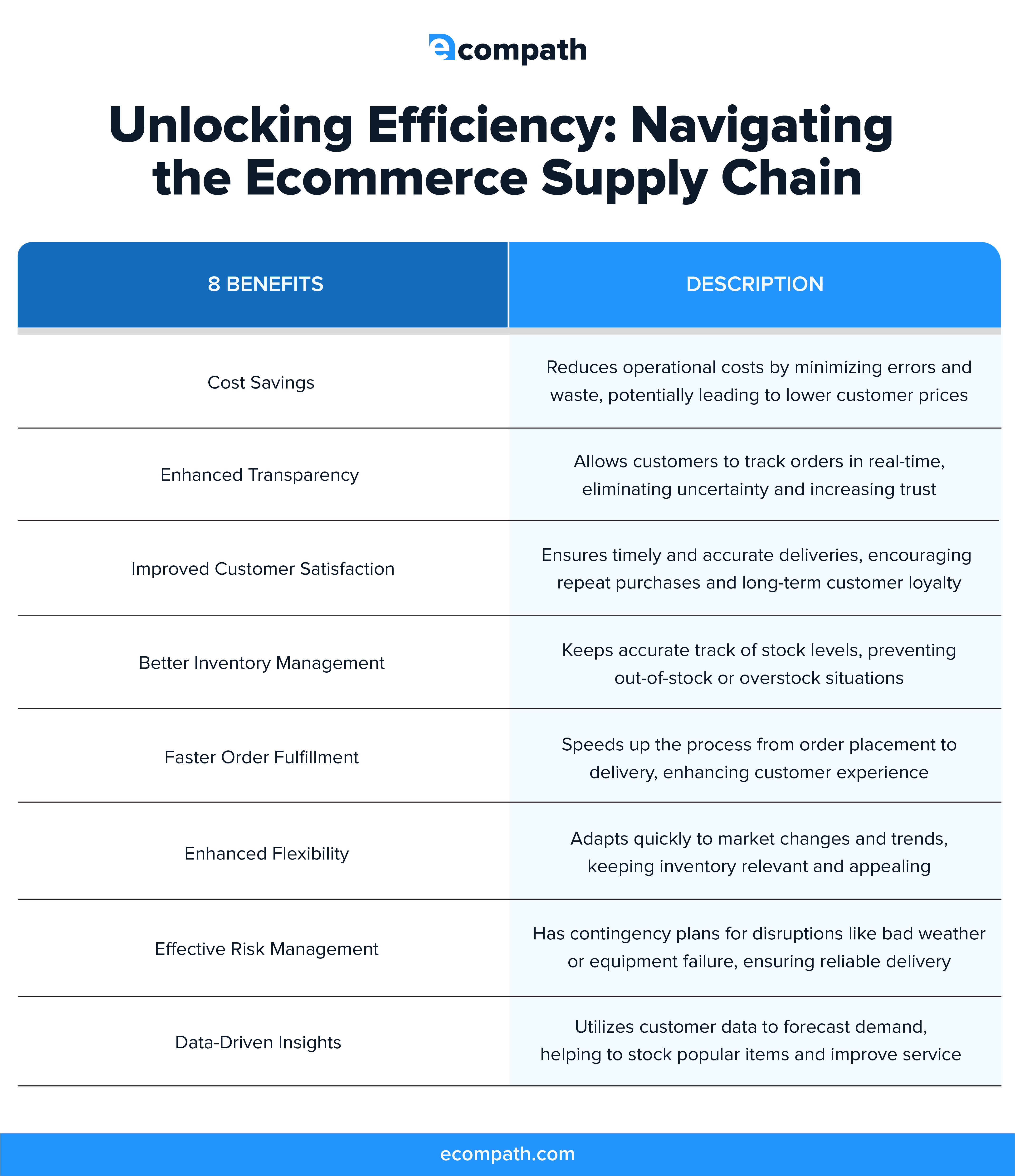Table of Contents
- What is Supply Chain Management in Ecommerce?
- Why Ecommerce Supply Chain Matters?
- Steps in Ecommerce Supply Chain
- Ecommerce Supply Chain Challenges
- Strategies for a Better Ecommerce Supply Chain
- Wrapping Up Ecommerce Supply Chain
- FAQs </div>
Ever wondered how your favorite online store always has what you want in stock? Or how it gets to your doorstep so fast?
Online businesses rely on steps to move products from factories to your doorstep. Think of it as a hidden guidebook that ensures a smooth operation.
Big companies and even small online shops can gain a lot from mastering this. Businesses can make customers happy by keeping track of products, managing warehouses, and speeding up deliveries. And a happy customer often comes back to shop more. If you’re in the ecommerce game, getting your supply chain right can make a big difference.
What is Supply Chain Management in Ecommerce?
You know when you click “buy” online and your package appears at your door? That’s ecommerce supply chain management at work. It’s a set of steps that online stores follow to ensure you get your stuff. This system keeps track of everything from when a product is made to when it lands on your doorstep.
But wait, how is this different from other businesses like restaurants or car dealerships? Well, online stores face unique challenges. They have to deal with website crashes, sudden spikes in demand, or even internet scams.
Unlike a physical store where you can see and touch products, everything is online. This makes managing the supply chain trickier because they have to predict what you’ll want to buy, keep their website running smoothly, and ensure they’re ready for surprises.
Why Ecommerce Supply Chain Matters?
Think of the ecommerce supply chain as the backbone of an online store. Sure, having great products and a flashy website is excellent, but what counts is getting those products to you quickly and without hiccups. A smooth supply chain makes sure that happens.
The experience of purchasing online could be a nightmare if this step is unsuccessful. Because of this, it’s crucial that internet retailers get this properly.
Let’s look into 8 benefits of optimizing the ecommerce supply chain:
Cost Savings
An online store with a well-organized supply chain can save a lot of money. How? Well, fewer mistakes in ordering and shipping mean less waste. Less waste means the store doesn’t have to spend extra money fixing those errors. Sometimes, the store shares these savings with you by offering lower prices or special deals.
Enhanced Transparency
Knowing where your package is always feels great, doesn’t it? A well-managed supply chain allows for easy tracking. This means you can see your package move from the warehouse to your doorstep. No more worrying or guessing when it will arrive; you’ll know exactly when to expect it.
Improved Customer Satisfaction
Everyone loves getting their orders on time and in perfect condition. A smooth supply chain makes this happen more often. Satisfied shoppers often return. This cycle strengthens the bond between you and the store over time.
Better Inventory Management
Imagine wanting to buy the latest video game, but it’s sold out. Annoying, right?
A well-managed supply chain helps online stores avoid this problem. Inventory management is crucial for these businesses. They know exactly what’s in stock and what needs restocking. That means you’re less likely to face the letdown of an out-of-stock item.
Faster Order Fulfillment
Nobody likes to wait forever for their stuff. A streamlined supply chain speeds up the whole process. The store can quickly locate items in the warehouse, pack them, and ship them out. As a result, you get your order faster, which is always a win.
Enhanced Flexibility
Markets can change quickly. Maybe fidget spinners will become the next big thing overnight. A flexible supply chain allows an online store to adapt to these changes fast. They can quickly stock up on trending items, ensuring you can get what’s hot right now without any delays.
Effective Risk Management
Things sometimes go differently than planned. A snowstorm delays shipments, or a truck breaks down. A robust supply chain has backup plans for situations like these. This ensures your order gets to you quickly, even when things go wrong.
Data-Driven Insights
Data is like gold for online stores. They use it to figure out what you might want to buy next. A smart supply chain uses this data to make important decisions.
For instance, if a store knows that beach toys sell like crazy every summer, they’ll stock up in advance. This way, they’re ready to meet the demand when the season hits.

Steps in Ecommerce Supply Chain
Ever wondered how your online orders go from a simple click to your doorstep? It’s not magic; it’s a well-planned system. Let’s explore the steps that make this happen:
Step 1: Market Research
Before anything else, online stores need to know what you want. They study trends and customer reviews. This helps them determine which products will be hits and which ones will be misses.
Step 2: Product Sourcing
Once they know what’s hot, they need to get it. Some stores make their own products, while others buy from different suppliers. The goal is to find quality items that people will want to buy.
Step 3: Balancing What’s Available and What’s Needed
It’s a tricky balance. Stores need to have enough of the popular items but only a little of the stuff that doesn’t sell. They use data and past sales to make these decisions.
Step 4: Organizing Warehouses and Keeping Track of Inventory
Think of a warehouse as a big closet for the store. Everything has its place. Computers help track what’s in stock and what needs to be reordered so nothing runs out.
Step 5: Website Management
A slow or confusing website can turn customers away. Online stores make sure their websites load quickly and are easy to use. This includes a smooth checkout process to make buying simple.
Step 6: Handling Orders Effectively
The moment you click “buy,” a whole process kicks off. The store locates your item in the warehouse, packs it up, and prepares it for shipping. All of this happens as quickly as possible.
Step 7: Payment Processing
Your credit card or PayPal info goes through a secure system. The store waits for approval before moving to the next step. Once the payment is okay, they know it’s safe to send your order.
Step 8: Managing Distribution, Delivery, and Return
Your package might travel by truck, plane, or even drone. The store chooses the fastest and safest way to get it to you. And if you need to return something, they have a system for that, too.
Step 9: Customer Support
Questions? Problems? Customer service is ready to help. Whether it’s tracking your order or handling a return, they’re there to make things right.
Step 10: Review and Improve
After your order is complete, the store takes a step back. They look at what went well and what could be better. This helps them improve so your next shopping experience is even smoother.
Ecommerce Supply Chain Challenges
So, you know how online stores get your orders to you, but it can be challenging. Let’s discuss the bumps in the road:
Managing Inventory Complexities
Inventory is like a jigsaw puzzle for online stores. They need to know exactly what pieces they have and where they fit. Sometimes, a popular item sells out super fast, leaving customers disappointed. Conversely, items no one wants can take up valuable space, costing the store money.
Organizing Warehouses Efficiently
Imagine trying to find your favorite toy in a room full of random stuff. That’s what a messy warehouse is like for online stores. Items can get lost or misplaced, causing delays in shipping. This frustrates customers and costs the store extra money to fix the mess.
Dealing with Complex Shipping Logistics
Shipping is more than just loading a truck and driving. Sometimes, products have to travel by plane or even by boat. And remember customs rules when shipping internationally. All these factors can make shipping a complex puzzle that needs careful planning.
Handling Customer Expectations
Customers are the bosses in online shopping. They want their orders fast and in perfect shape. But meeting these high expectations every single time is a big challenge. One small mistake, like a late delivery or a damaged item, can turn a happy customer into an unhappy one.
Adapting to Market Changes
Remember when fidget spinners were all the rage? Trends like that can change almost overnight. Online stores need to be quick on their feet to adapt. If they’re too slow, they could avoid big sales or end up with a warehouse full of stuff no one wants anymore.
Strategies for a Better Ecommerce Supply Chain
You’ve heard about the challenges, but what about solutions? Online stores can do several things to make their supply chain better. Let’s dive into some smart moves:
Checking and Adjusting the Supply Chain
Online stores should make it a habit to review their supply chain often. This means looking at how fast products move from the warehouse to the customer. If they find any slow or broken parts, they should fix them right away to avoid more significant problems later.
Using Automated Tools for Orders
Technology can be a game-changer. Automated tools can handle orders much faster than humans can. These tools check for errors and can even suggest the best way to pack and ship items. This helps the store process orders quickly and with fewer mistakes.
Considering Outside Help for Shipping
Shipping is a big deal. Things can get messy if an online store tries to do it all alone. Partnering with established shipping companies can make this process smoother. These companies already have the know-how and resources to deliver packages quickly and safely.
Smartly Arranging Warehouse Space
Think of a warehouse like a giant puzzle. Every piece, or in this case, product, has its place. Online stores should arrange their warehouses in a way that makes it easy to find and grab popular items. This speeds up the whole process and reduces the chance of sending the wrong thing.
Investing in Customer Service
A good customer service team can make a world of difference. They’re the ones who handle complaints, answer questions, and solve problems. Investing in training and tools for customer service can prevent minor issues from turning into big headaches.
Using Data for Better Decisions
Online stores collect a lot of information about what people buy and when they buy it. This data can help predict future trends. For example, if a store knows that people buy more swimsuits in May, they can stock up in April. This way, they’re ready when the demand hits.
###Planning for the Unexpected
Life is full of surprises. Trucks break down, storms happen, and sometimes, a product becomes super popular overnight. Online stores need a solid backup plan for these unexpected events. This could mean having extra stock or an alternative shipping route ready to go.
Wrapping Up Ecommerce Supply Chain
So, you’ve learned a lot about how online stores get your orders from a click to your door. It’s a big job with many steps and challenges. But with smart planning and flexible solutions, online stores can make it all work smoothly. Good management is the key to keeping both the store and its customers happy.
FAQs
What is an Ecommerce Supply Chain?
It’s the system that moves products from the manufacturer to your doorstep when you shop online.
What are the Benefits of Ecommerce Supply Chain?
It can save money, make customers happy, and help stores run better.
Is the Supply Chain a Function of Ecommerce?
Yes, it’s a crucial part that makes online shopping possible.
What is Value and Supply Chain in Ecommerce?
Value is what you get for your money, like quality and speed. The supply chain is how online stores deliver that value to you.
What is the Importance of E-Logistics in Supply Chain Management?
E-logistics ensures that your order reaches you quickly and intact. It’s an essential component of the entire system.



